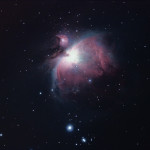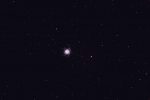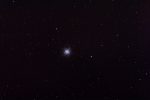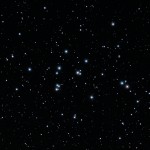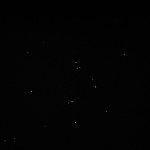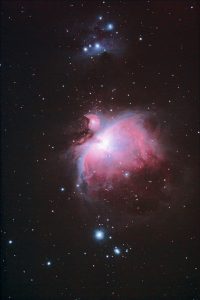OK, I have heard many times about BackyardEOS for controlling Canon EOS cameras used in Astrophotography. Unfortunately my 1st generation Digital Rebel (300D) with its now ancient DIGIC-I processor is not a supported platform. Even though it does have USB and you can trigger the shutter through that you can only use the predefined exposure lengths up to 30 seconds. You cannot use Bulb mode through the USB port, only through the 2.5mm phono plug. The 300D only has USB 1.1 so even if you could hold the shutter open indefinitely, downloading a full raw image would take an age. Added functionality in the DIGIC-II and greater processors includes things like sub-frames and live view which lets you do lovely things like live preview for frame and focus. I didn’t realize how incredibly useful that was until I borrowed my mom’s 1100D and tried BackyardEOS out for myself. Let me tell you, that is WONDERFUL. I didn’t get to experiment with the drift alignment routine in BYEOS but if it is even as simple as the parallel crosshair it is a useful tool indeed. BackyardEOS is a complete bargain for $30, $38 if you want to use ASCOM to control the focuser. What’s that ASCOM plugin all about? Well, if you have an ASCOM compliant focuser and the appropriate drivers on your PC, BYEOS can do all the FWHM auto-focus thing for you so all you do is find a nice star to focus on and press GO! Then magic happens and your image is focused for you. Fan-frickin-tastic! Great stuff that BYEOS
Category Archives: Commentary
Commentary on things related to astronomy, astrophysics, astrophotography, equipment, design, processing techinques, people, places, events, etc. and other such things that may not fit well elsewhere.
M42/43 once again.
Shot from the backyard in Allen, TX on 2013-01-20 @ 2300 CST. The seeing was pretty darn good, humidity was high as was the light pollution but it was bearable for my first time seriously out with the scope in a while. Camera control was through BackyardEOS which I’ve decided is the bee’s knees. If you have a Canon camera that has USB 2.0 on it, check this lovely bit of software out. Well worth the $30, $38 if you have an ASCOM focuser and want BYE to autofocus for you.
M42/M43 (Great Orion Nebula)
15 x 30 seconds
30 x 120 seconds
Borrowed Canon T3 (Thanks Mom!)
Meade LXD75/SN6
Baader IDAS-LPS
Baader MPCC
The time has come, FINALLY
After seemingly unending weeks of temperatures over 100F during the day and 85F at night with at least 60% humidity we get some relief. It came in the form of Tropical Storm Lee which pummeled the East Coast with rain for days on end once again flooding large portions of Tennessee but the break in temperatures is very welcome here in North Texas. The moon is about 75% full so deep sky photography will be challenging but I took some pictures of the moon, just in case. At least the night won’t be a total loss now even if everything goes completely pair shaped. Currently the temperatures are in the middle 70’s and the humidity is in the upper teens to lower 20’s with calm winds. Only barely enough gust to keep the air from being completely still. Currently the SN6 is trained on M27 and snapping away happily after a small amount of minor drama. I took my time getting set up but I bumped the tripod lightly with my foot while aligning the mount. Hopefully no ill will come of that. We shall see in the morning.
Maybe tonight?
It’s been oppressively hot here in Tejas recently but I’m starting to get the itch to play under the stars once more. I needed to give my declination axis a tune so I did that last week hoping to use it when it was actually looking like it might get into the 70’s overnight. Granted it wasn’t much into the 70’s with lows forecast at 78F and 79F but it was less than 80F at least. I just got a Clear Sky Alarm Clock notification that the sky is favorable tonight so I may ponder this over dinner.
Into the breach once more . . .
After several long months of fighting colds/flu and cruddy weather, lack of motivation from having to collimate my scope once more finally got the better of me. A quick and dirty process of some quick and dirty data on a night with a half moon high in the sky. Shot from the Dallas-area suburb of Allen under clear, cold and less than 50% humid skies. Envisage kept crapping out on me so I fired up PHD Guiding which of course worked perfectly. Once more hats off to Craig Stark for volunteering his time and effort to make our lives easier in providing an excellent autoguiding package free of charge. Check his software out and support him if you haven’t already.
Equipment:
- Meade LXD75 – SN6
- Canon 300D (unmodified)
- StarBlast 4.5″ Newt + Meade DSI on guide duty
What a difference a (few) years make
I was digging through some old data and thought I might reprocess my M13 data from three years ago. Man, what a difference! Some of it is software, some of it is technique, some of it is experience.
The old M13 on the left, the reprocessed data on the right:
The Manger
Messier 44, The Beehive Cluster, Praesepe. This is one really large object. It is 95 arc minutes (a bit more than 1.5 degrees) in angular size. It’s big enough that it won’t fit in a single frame on my Canon 300D with my f/5 Schmidt-Newtonian scope. That officially makes M44’s dimensions Big by Large! Located about 545 light years from home, M44 is a relatively close open cluster of stars and one of the closest stellar objects. It is large enough and bright enough that in a relatively dark sky it is easily discernible with the naked eye and is spectacular through binoculars.
Personally I have a warm fuzzy spot for M44. Many years ago when I first started picking up astronomy magazines I looked through the charts, read the articles and saw that Saturn was traversing M44 which made it very easy to find in suburban skies. It was the first deep sky object I looked at through my department store telescope and I was instantly hooked. It was also the first image I took of a DSO with my point-and-shoot digital camera clamped to my eyepiece in the same department store telescope. Now, years later, I finally snapped another image of an old favorite.
Betelguese, Betelguese, Betelguese!
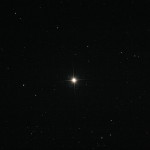 Single exposure shot in jpeg. Unguided 60 second exposure with Meade LXD75 SN6. Canon Digital Rebel (300D) ISO 1600. Diffraction spikes made with gaffers tape across the front of the scope. I shot this as a focus test shot at the local dark sky site at the LBJ Grasslands near Decatur, TX last night. Some fool forgot his Bathinov masks and had to use gaffers tape to make diffraction spikes for focusing. I thought this might help some others and for this kind of target I think diff spikes can look pretty cool.
Single exposure shot in jpeg. Unguided 60 second exposure with Meade LXD75 SN6. Canon Digital Rebel (300D) ISO 1600. Diffraction spikes made with gaffers tape across the front of the scope. I shot this as a focus test shot at the local dark sky site at the LBJ Grasslands near Decatur, TX last night. Some fool forgot his Bathinov masks and had to use gaffers tape to make diffraction spikes for focusing. I thought this might help some others and for this kind of target I think diff spikes can look pretty cool.
Mount is up and ready to go, so it’s cloudy.
Over the last several weeks I’ve spent some time giving my LXD-75 some much needed TLC. I disassembled the Dec and RA axes, cleaned them and examined the nylon bushings. I hadn’t looked at the bushings before but now I understand why kits are available with replacement teflon bushings. I could have cut better bushings from a piece of acetate with an Exacto knife. The edges were rough with several places where it was obvious the press used to stamp them out of sheet was worn far beyond acceptable. A quick run over them with some 120 grit to knock of the really rough stuff followed up by some 1,200 grit to smooth the edges made them more acceptable. Add some SuperLube to that and they’ll be serviceable until I finally replace them with those relatively expensive teflon bushings. If only Meade would be willing to spend just a small amount of time doing QA during assembly these mounts wouldn’t have the awful reputation they do.
Regardless I’ve got my mount as good as it can be with the sloppy gearing made by underpaid, over worked, sub-par Chinese labor. I don’t know about you but I’d be willing to pay twice as much for a US built mount with a little bit of reasonable QA done and slightly higher quality materials and craftsmanship. Meade really, really needs to have a mount on par with the Celestron CGEM. To match the price point they’d have to make it in China, just like Celestron, but if they could find a way to manufacture or at least assemble them in the US for a reasonable amount more, I’d be willing to pay for that.
First image of 2010
I took this image of M42/M42/NGC1977 on January 12th after re-remembering how to accurately align a mount that isn’t permanently installed. I took about an hour and a half of subs with several having to be rejected for one reason or another. I still am having a problem with my serial shutter cable which I may repair and I may just replace with a commercial offering. I’m still undecided. Regardless this image represents just under an hour of exposure, 115-ish exposures of 30 seconds each. It was stacked with DeepSkyStacker and edited with The Gimp. I probably should pull this into PixInsight and preserve as much data as I can but I’ll reprocess the data at a later date. I was pleased as punch just to be out under the stars and collecting ancient photons again.

